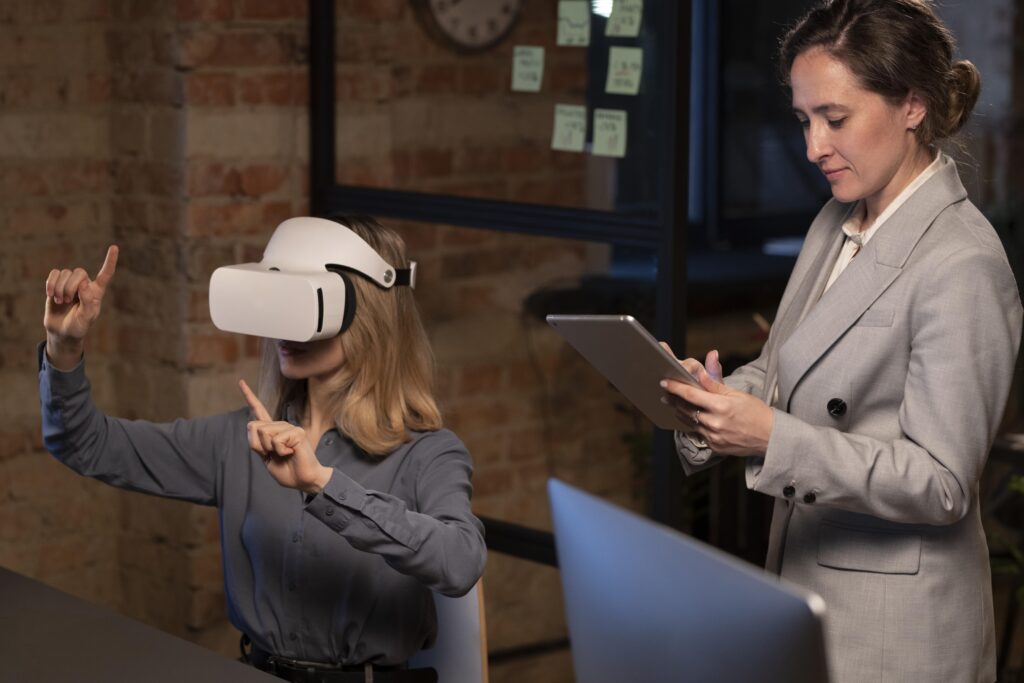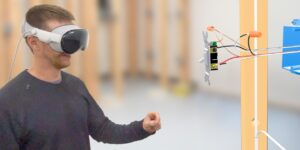As the world of field service continues to digitize, instructional design is becoming an increasingly crucial component of the industry. The best augmented reality apps for instructional design are leading the way, revolutionizing traditional methods by virtue of new and innovative approaches to field service training.
A recent article by Oracle noted that improved knowledge sharing is among the most crucial trends in field service management:
It’s harder to collaborate and share knowledge when the team is geographically dispersed, constantly in motion, and working on a wide assortment of problems. Because of these challenges, companies turn to technology, which plays an important role in knowledge sharing by providing mobile field service workers with access to information they need to do their jobs.
This trend manifests itself in multiple ways. Enhanced by technology like augmented reality (AR), workers can be better prepared when arriving at sites while also tapping into knowledge more easily while on the job. It’s no surprise then that, according to a recent Gartner report, companies that leverage AR for their field service operations not only improve their first-time fix rates by 20% but also reduce overall service costs by 10%.
A Future Forged by the Best Augmented Reality Apps for Instructional Design
As we look toward the future, these AR apps are leading the way in revolutionizing how we think about instructional design in this arena. The ability to incorporate cutting-edge features like 360° views, interactive touch-screen manipulation, and animated 3D guides, along with inherent portability, can elevate the training experience to new heights.
Related: A Guide to the Apps Today’s Field Techs Need for Success
To get there, of course, you must understand how to evaluate and find the best augmented reality apps for instructional design in the field. After this deep dive into the world of AR training apps, you’ll be well-prepared to leverage a solution that can truly enhance the way you train and develop your field service workforce.
Common Characteristics of the Best Augmented Reality Apps for Instructional Design
Before digging into the specific types of apps that can benefit your field service training, it’s important to consider the characteristics they often share. This general knowledge will ultimately help you identify the best augmented reality apps for instructional design based not just on your own demo but proven features you know are important.
- Immersive experiences. The key to successful augmented reality applications is the fact that their offerings are truly immersive. By incorporating interactivity that uses multiple senses and blending the real world with digital enhancement, they offer audiences the chance to dive into the subject matter deeper and more realistically than any standard video or static media ever could.
- A strong connection to reality. To be clear, augmented reality is not virtual reality. There still has to be a strong connection to reality, which enables the audience to easily make that continuous real-world connection. The digital elements layer over instead of replacing the real-world environment they’re designed to augment.
- Ease of use. In field service and many other industries, the audience of augmented reality training apps might not be technologically proficient. That means any instructional app they use has to be as easy to use as possible, making it simple to transition into using augmented reality instead of more traditional means of training.
- Ease of build. Just as user-friendliness matters, the AR app should make have intuitive designs for developers and instructional designers to create new instructions or modules. It’s the only way to take full advantage of the technology, making it easier to continue building, updating, and improving training features that your field service workers can use.
- Portability. Avoid apps that require bulky equipment to use. They’ll be difficult to implement for training in a field service environment that thrives on being nimble and agile. Instead, look for portable apps that can be accessed on a mobile device and used by your workers without any special equipment, creating a smoother transition to training and optimization.
Combine these features and you maximize your chances of finding AR apps specifically designed to help you optimize your instructional design processes and field service training. It’s the perfect foundation to have as you look to build your tech stack with applications optimized for your field service professionals at every level.
Moving From Traditional Paper Manuals to AR Instructional Design
Before diving into the best augmented reality apps for instructional design, it helps to understand just why the move may be necessary to begin with. Outdated static manuals can be difficult to use in training scenarios. They’re extensive, making it challenging to find specific sections or areas on which your team needs training. Worse, they can be unclear and quickly become outdated, making them impractical for any type of instructional design.
Dynamic and mobile-enabled apps, on the other hand, can go a long way toward improving the training experience. The right apps deliver hands-on, clear, visual guidance for tasks ranging from complex assemblies to field training and review.
Of course, making the switch can also be cumbersome. That’s why many AR apps for field services vow to simplify it with options that convert traditional manuals to immersive instructions. That minimizes barriers for instructional designers, enabling them to focus more specifically on the qualitative aspects of building training modules instead.
The Best Augmented Reality Apps to Improve Your Field Service Learning
It’s time to get specific. The following field service apps can help you build a modern, immersive environment for your workforce that speeds up your ramp-up times, reduces your reliance on support calls, and enhances overall efficiency and productivity. Of course, they’re not mutually exclusive of each other. Rather, each one offers its own unique benefits to build your instructional design tech stack.
Acty
Terming itself a visual assistance program, Acty is an app designed for field service. It enables professionals working on complex machinery to speed up fault diagnosis and resolution by layering virtual environments with context about each piece of machinery over the real image, streamed to either a mobile device or smart glasses.
Related: 7 Strategies for Effective Training with a 3D Work Instruction App
Better yet, the app can transmit the images created through its AR capabilities directly to remote workers for additional assistance despite the physical distance. When creating a system of remote fieldwork (and especially for training new employees), it can become a valuable asset to streamline processes and communicate even the most complex information quickly.
TeamworkAR
Similar to Acty, TeamworkAR overlays virtual visuals over complex pieces of machinery to make it easier to understand them. According to internal research, TeamworkAR claims that its features can reduce the error rate for assembly processes by more than 80% thanks to building more intuitive learning steps.
The app also leverages a few extra features to increase its usability. Integrated video chat makes remote collaboration easier. Meanwhile, direct integration with other enterprise systems allows for the connection of immediate training to larger business success metrics.
AR FSM
Softweb Solution’s AR FSM app takes the process one step further. The app can overlay complex data onto any piece of equipment, enabling professionals in the field to better understand its context. That adds to other features like AR training simulations, which help engineers familiarize themselves with the environment before they step foot in it.
Other features benefit fieldwork instructional design as well. For example, viewing equipment through the app enables users to identify specific objects within them while voice commands allow for hands-free operation of the app. Ultimately, it’s a more complex solution than the others mentioned above, but its unique features are undeniably beneficial in field work.
Help Lightning
Dedicated to spatial computing, Fieldbit’s Help Lightning platform is designed for fast results. Organizational know-how and quick facts easily integrate into the virtual display that overlays the physical product or equipment, backed up by real-time IoT data.
This level of AR visualization is perfect for field service training. It enables modules that help trainees and instructors alike to quickly get to the source of any issue, while seeing real-time warnings, statuses, and other labels. Information exchange between techs and trainees also speeds up, ultimately increasing efficiencies across the entire process.
BILT
Finally, BILT is one of the best augmented reality apps for instructional design, and it shines in its intuitiveness. Instead of complex displays or integrations with external devices, it offers immersive, 3D instructions specifically designed to help field service workers get to the root of any issue, assembly, or repair quickly and efficiently.
But don’t let this intuitiveness fool you: BILT offers a comprehensive experience, with instructional designers who create advanced, high-detail 3D animated guides and other integrations to develop an interactive training experience for field workers. With a touchscreen interface, your workers can pinch, zoom, rotate, and fully manipulate images for full comprehension of whatever installation or product they’re working on.
The Best Augmented Reality App for Instructional Design Starts with Hands-On Instruction
As the field service industry undergoes digital transformation, instructional design becomes increasingly vital, with augmented reality (AR) apps leading the charge. These apps revolutionize traditional training methods by offering innovative approaches to field service instruction. As the industry evolves, integrating such cutting-edge technologies will undoubtedly redefine how we approach field service training, ensuring enhanced productivity and success for years to come. BILT offers intuitive 3D instructions designed to streamline field service efficiently and without special equipment. With features like interactive manipulation and comprehensive 3D guides, BILT exemplifies the future of AR-enhanced instructional design, empowering field service professionals to excel in their roles with confidence and proficiency. Request a demo today and start taking advantage of powerful immersive instructional experiences.



